蜃気楼階段イタリア版, Mirage Stairs / Maranola, Scale-Juggling Escalator
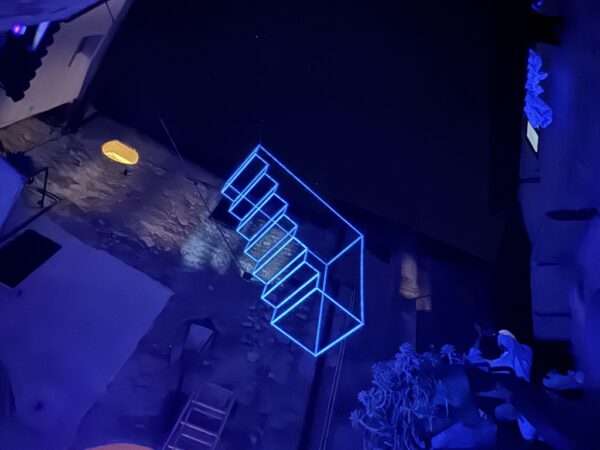
「蜃気楼階段/Maranola」 は、イタリアの中世の町Maranola で制作した新しい「手続き型建築」のモックアップである。「手続き型建築」とは、美術家の荒川修作+マドリンギンズが提唱する建築のあり方である。通常、建築は、日常生活の中で身体との関係性の中で、多くの「手続き」を通して使用されている。「手続き型建築」では、既知の「手続き」を問い直し、建築と人間との間に新しい関係性と環境を生み出すために意図的に設計された建築のことである。「手続き型建築」には「使用法」があり、それに従って使用することによって、人間が作り変えられ天命が反転されるという思想である。
今回、イタリアで新しい「蜃気楼階段/Maranola」が生まれる経緯や背景に関してはあとで説明するが、まずは作品の概要について説明したい。
English Text Follows in the end of the Article.
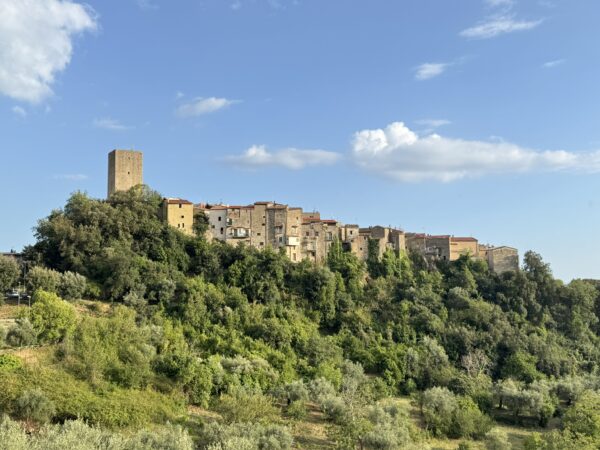
設置場所について
敷地はイタリアの西海岸、ローマとナポリの間の高台にある中世の城壁都市Maranolaにある。街は海岸から急勾配でせりあがる山の地形の起伏に沿って作られているため、そこにはほとんど平らな道がなく、坂道の路地や階段が入り組んでできている。そしてその階段は住まいの中にも続いており、いくつかの住宅が階段を共有しながら複雑に積み重なって上方向に延びている。そして、その階段を登り切ると周辺の山や海のランドスケープを一望する屋上テラスへと誘われる。この町では大地と街と住まいと暮らしが、階段によって有機的に結ばれている。
この街に住む人は、街中でも家の中でも日々階段に囲まれて暮らしている。生まれてから死ぬまで生活の中で必要に応じて幾度となく階段を上り降りする。階段は、この町で生まれて育った人にとっては、大地の一部であり、街の一部であり、建築の一部であり、それらは、生活を営むための不可欠なものとして日常生活の一部になっている。そんな階段だらけの町中の小さな中庭に蜃気楼階段を設置することになった。
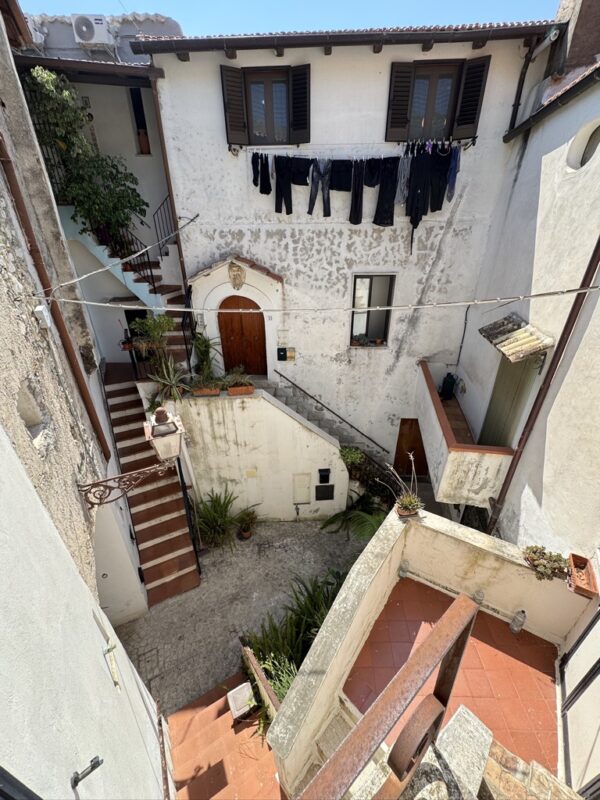
中庭を「手続き型建築」に変容させる。
その小さな中庭は、8本の階段と7軒の家が上下左右に複雑に絡み合い、まるでエッシャーの絵画が立体になったかのような場所である。わたしは、今回、マラノラの人々にとって最も身近にある「階段」を通して、この中庭を「手続き型建築」に変容させることを試みた。まず、7本の既存の階段の向きを調査し、それらと違うベクトルをもった2つの「フレーム階段」を広場の真ん中に宙吊りに設置する。下部のものは、通常よくある階段のサイズを約2分の1に縮小した大きさ、上部のものは縮尺を約3分の2に縮小した大きさになっている。そして、それらを重力に囚われない存在にするため、上部の「フレーム階段」は天地を逆転させ、かすかに傾けて宙に吊り下げることにした。そして、それらに蛍光塗料を塗り、日没後、光って見えるようにした。日中は見えている既存の階段は、夜になると闇に包まれ、みえなくなり、中に浮かぶフレーム階段だけ見えるようにした。
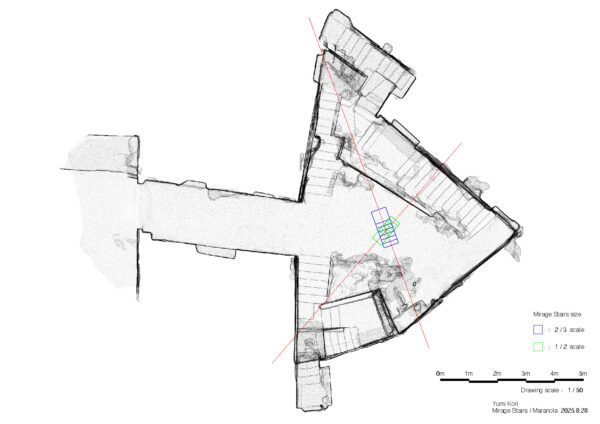
「蜃気楼階段/Maranola」の使用法
複雑に絡み合った中庭の階段を登ったり降りたりしながら、気が向いたところで立ち止まり、様々な高さや方向の視点から、宙に浮かぶ2つの「フレーム階段」と、7つの既存階段を見る。見る視点によって、中庭の形が違って感じられたり、天地が逆転して感じられたりする感覚を楽しむ。また、自分がいる場所によって、「階段」の大きさが違ってみえたり、「階段」が逆さに見えたり、また、自分の身体が大きくなったり小さくなったり、平衡感覚が乱される感覚を楽しむ。視点を変えることで、「階段」が登るものではなく、先にあるかもしれない別世界への入口として未知の世界に行くことを想像してみる。
日没後は、既存の階段が見えなくなることで、鑑賞者は、階段を昇降しながら身体的な感覚をとおして階段の存在を認識してみる。同時に、登れない「フレーム階段」を登ってみることを想像し、身体と視覚の空間認識の意識のずれを楽しむ。
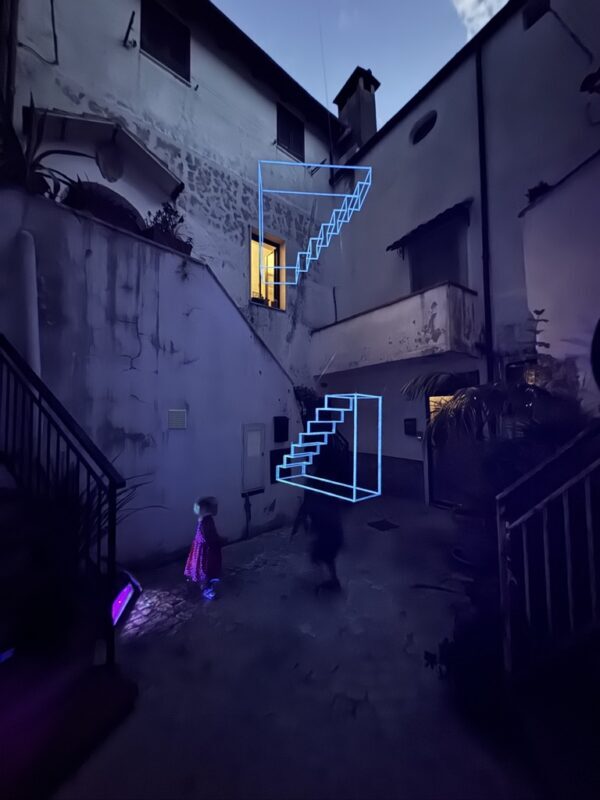
戸惑う感覚で「手続き型記憶」にアクセスする。
宙に浮かぶ2つの「フレーム」は、見慣れた階段の形状であるあるため、これをみた人は一眼でそれを「階段」として認識する。しかし、実際は細いフレームでできているので登ることはできない。また、それらは、通常の階段に比べて縮小されているため、成人が機能的に昇降できる大きさよりかなり小さい。しかも、宙に浮かんでおり、上部の階段は逆さま斜めに吊り下げられている。人々がそれらをみて「階段」だと認識した後に、それが実際に自分の身体を使って昇れる大きさであるかないかを判断するプロセスが脳内に起きるとき、人々は自分の身体感覚と空間認識の間を行ったり来たりするだろう。しかも、人々はその中庭にある実存階段を昇降しながら、このフレーム階段を様々な方向から認識するので、登れる階段と登れない階段、二つの間で戸惑いを感じるだろう。ここで覚える感覚を通じて、「階段」と人、ひいては建築と人、町と人は新しい関係をむすび直すことになり、この中庭自体が「手続き型建築」に変容するのではないかと考えた。
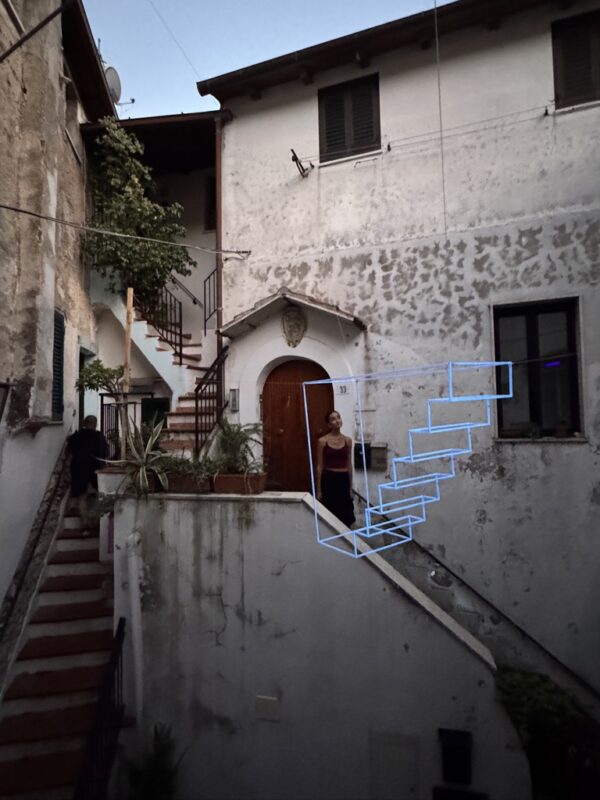
Scale-jugglingに関する考察
人間の脳が縮尺(スケール)をどう理解して行動に結びつけているかは、心理学や認知科学の分野で研究されている。まず、視覚情報は網膜にフラットに伝わるので、最初は実際の物の大きさと縮尺模型の大きさの違いは区別されない。しかし、脳は、光や影、奥行きなどの情報を加味し、経験値を参照して縮尺を理解し、それを身体感覚に置き換え、それに基づいて脳内でシュミレーションし、判断し、行動すると言われている。つまり、現実の階段を昇降しながら、実際には登れず、微妙に大きさの違う「階段」の存在を見る時、体験者の脳と知覚、手続き型記憶と身体感覚はいつもとは違う交信を行うため、人々の「建築的身体」が更新されるのではないかと考えた。
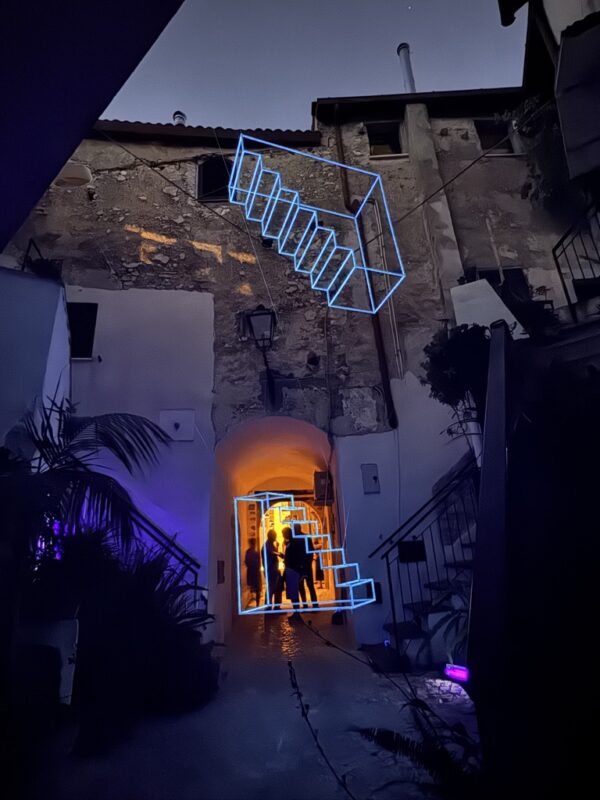
モックアップの意図
既存の階段を体験しながら、微妙に縮小された階段を様々な角度から見ることで、自分自身の身体の大きさ、周りの環境の大きさを相対的に感じてほしい。また、足や手、体重のかかり方やバランス感覚、視線の動きなどを、空間との関わりの中で自分の身体を敏感に感じるようになってほしい。既知の階段とは異なる色・形・傾き・形状などが、人々に違和感やズレを感じさせ、人々の身体感覚や空間認識を揺さぶり、日常空間が新鮮になることを考えた。また、階段は元来、単に機能を満たすだけのものではなく、見た人の心に訴えかけ、その先へと想像力を掻き立てる力がある。この作品を通して、人々の想像力を通してさらに身体意識が拡張されることを願う。
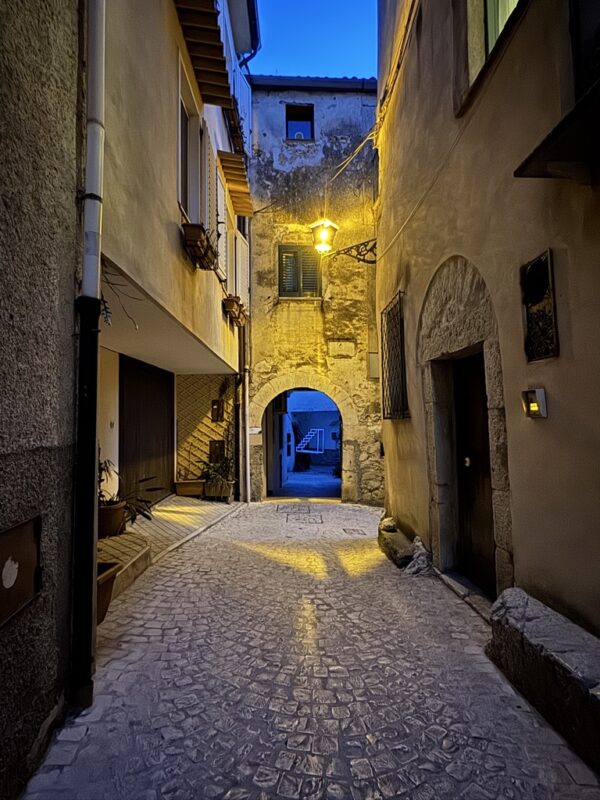
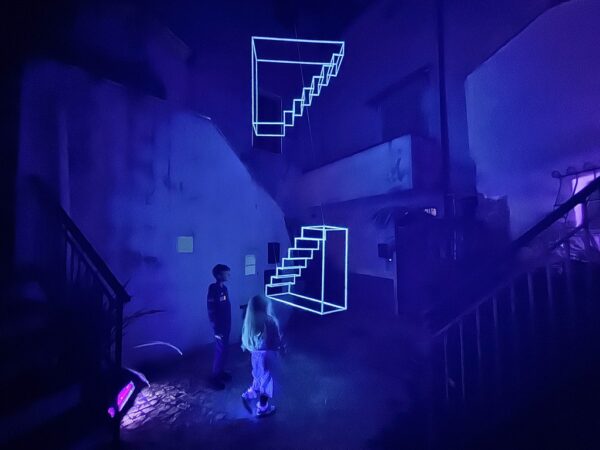
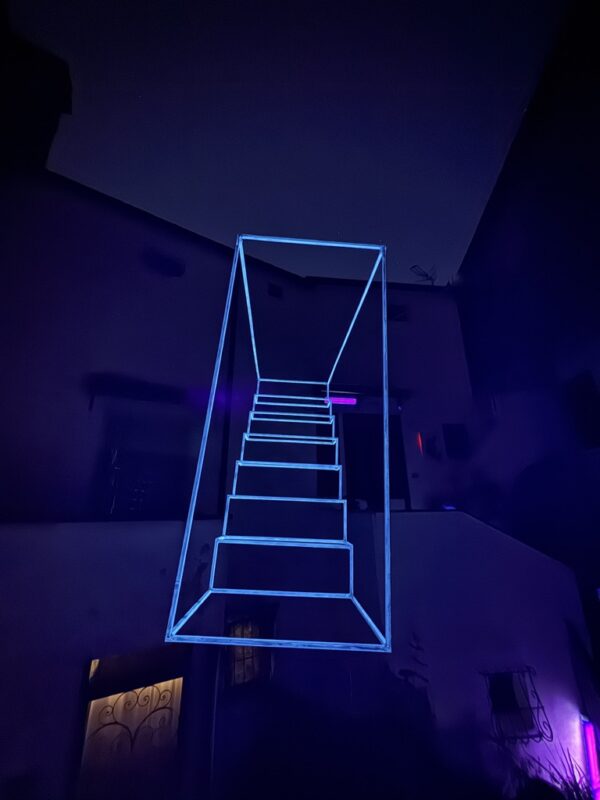
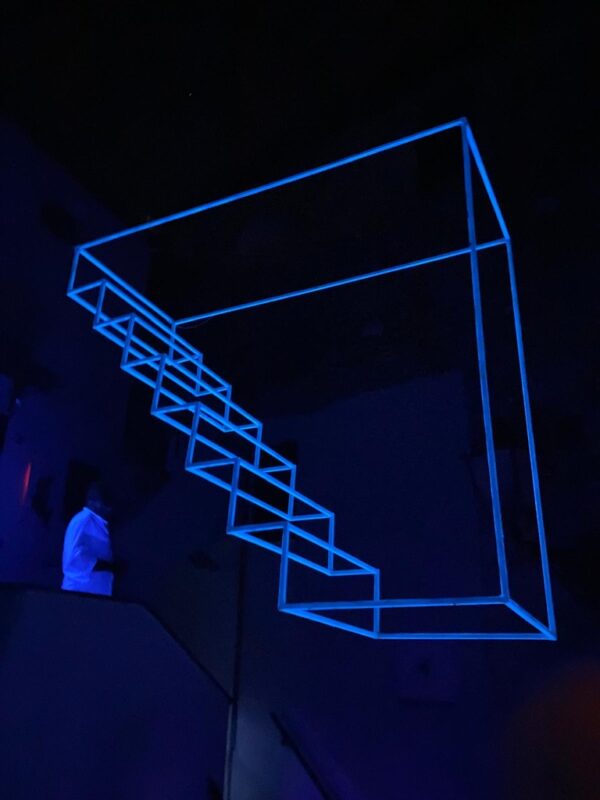
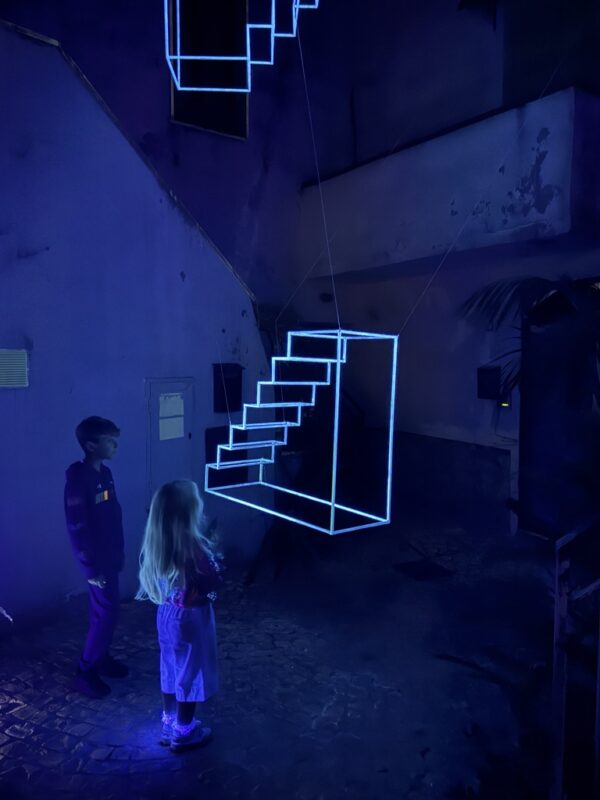
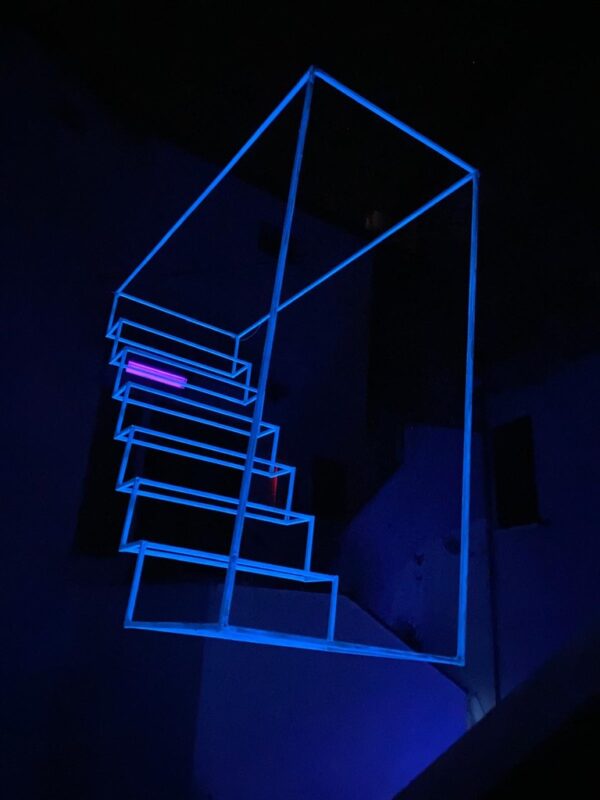
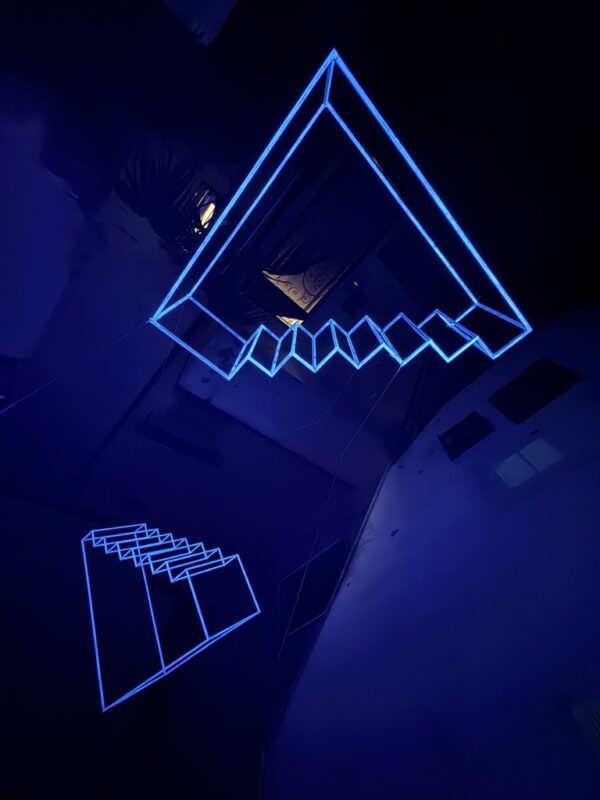
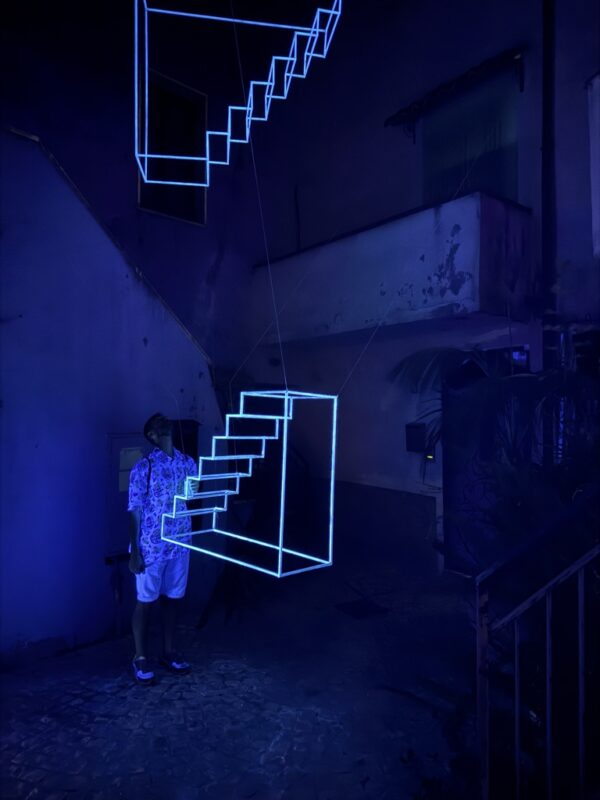
「Biotopological Scale-juggling Escalator」
「蜃気楼階段/Maranola」は、荒川修作+マドリンギンズの晩年の作品「Biotopological Scale-juggling Escalator」に着想を得て製作した。コム・デ・ギャルソン社とのコラボレーションによって実現したこの作品は、ニューヨークの市内にあるDover Street Market の3階と4階をつなぐ実際の階段である。“Reversible Destiny Lifespan Extending Module”(寿命延長モジュール)と呼ばれている。実際の建築の一部で機能的な階段でありながら、階段の素材や色は段ごとに違え、歩行のリズムや登り降り時の身体感覚を多様にし、体験者の空間の認識を活性化する。そして、その階段の壁面にはいくつかのモジュールの“部屋”(wing)の縮小モデルが埋め込まれており、それらを通して体験者が自分自身の大きさ・環境の大きさを相対的に感じ、日頃慣れ親しんでいる身体感覚を揺さぶることが期待された。「階段を上り下りすること」を通じて、身体が自分を取り巻く空間(建築的環境)と新しい関係を持ち、認知・感覚が刺激されることを狙っている。
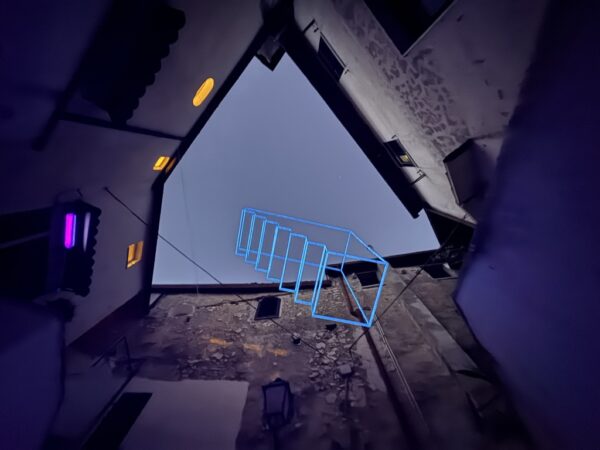
「蜃気楼階段/Maranola」誕生の背景
「蜃気楼階段をイタリアで展示してください」今年の春、そんな嬉しいラブコールをいただいた。2025年8月28〜30日にイタリアのMaranola行われるPublic Art Biennale で展示し、レクチャーもしてほしいということ。先日、来日されていたイタリア人のキュレーターの方に、昨年大阪で試作した「蜃気楼階段」の写真を見せながら「手続き型建築」研究の話をしたのがきっかけだった。そこで設計図面をイタリアに送り、現地で「蜃気楼階段」の制作を進めてもらうことになった。
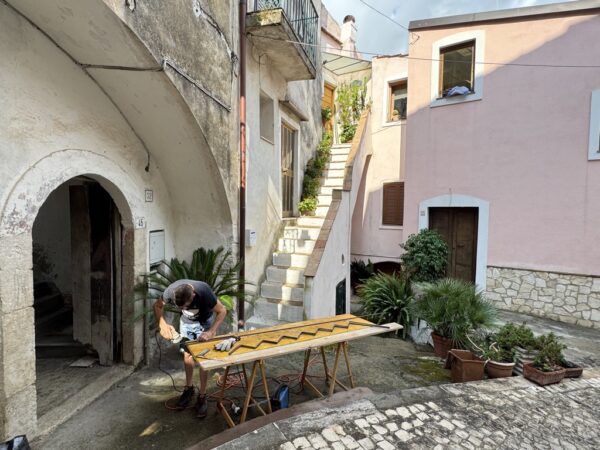
ところが、8月の初旬になって、キュレーターから緊急の連絡が入った。予定していた材料が手に入らないので予定通り「蜃気楼階段」を作ることができないという。すでにビエンナーレのプログラムも発表されている。なんとしても「蜃気楼階段」を作らなければならない。そこで、現地で手に入る材料で、現地の職人が作れる技術レベルで可能な「蜃気楼階段」を製作してほしいという依頼が届いた。しかし、「蜃気楼階段」のコンセプトを踏襲した制作可能な代替え案を急遽考えるという難問に応えるためにはどうしても現地に行く必要があった。急遽、予定を早めてイタリアに飛ぶことになった。
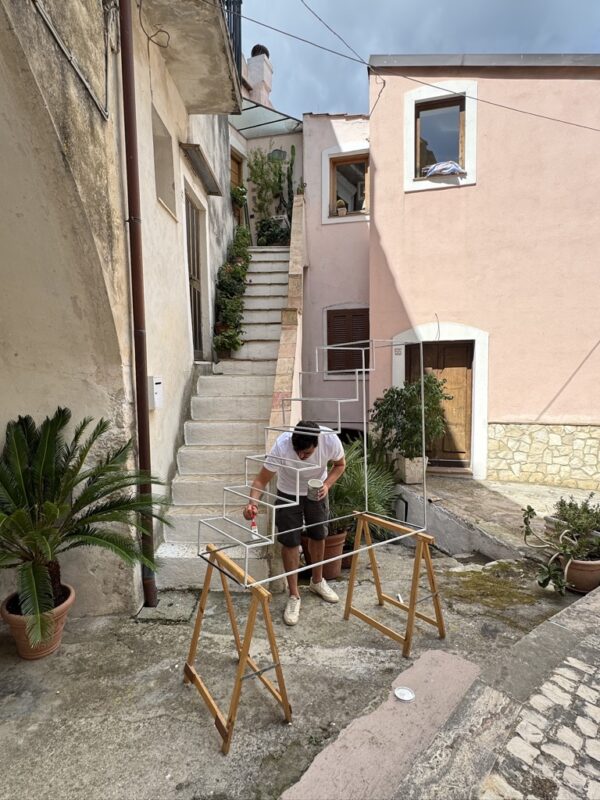
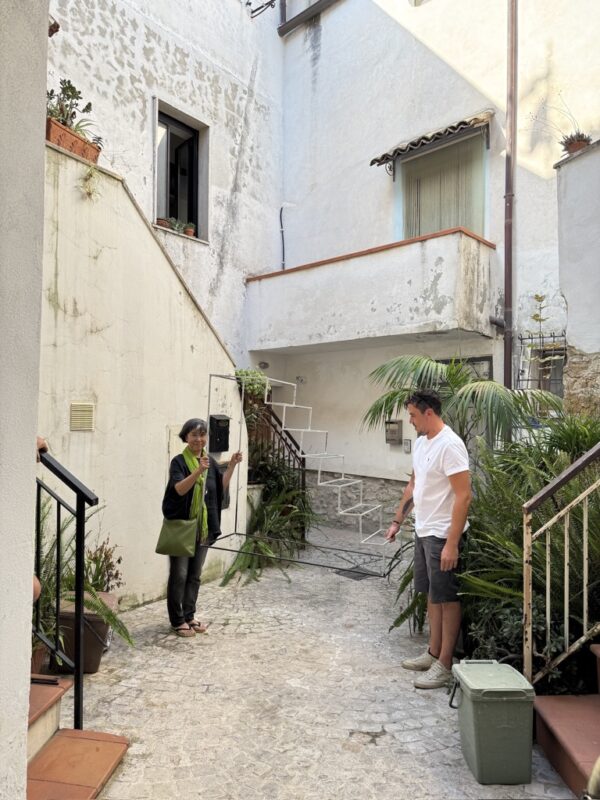
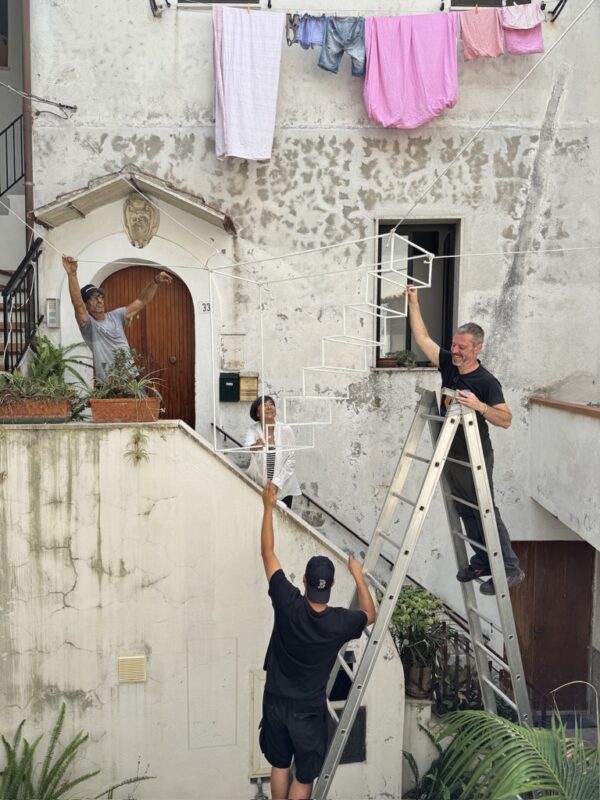
マラノラについてさっそく設置を予定していた中庭を訪れると、そこは写真に写っているよりずっと小さかった。しかし、数えてみると全部で7本の階段、8軒の家が立体的に絡み合っており、味方によっては計り知れない広がりのある空間にも思えた。そこで、「大きさ」や「スケール」に着眼して、新しい手続き型建築のモックアップ 「蜃気楼階段/Maranola」を作ることを思いついた。また、エッシャーの絵のように天地がひっくり返る騙し絵のような空間性を感じたため、「天地の感覚」にもアクセスする作品にしたいと考えた。また、実用と非実用によって同じものがどう違って見えるのかという認識に関しても興味が湧いた。
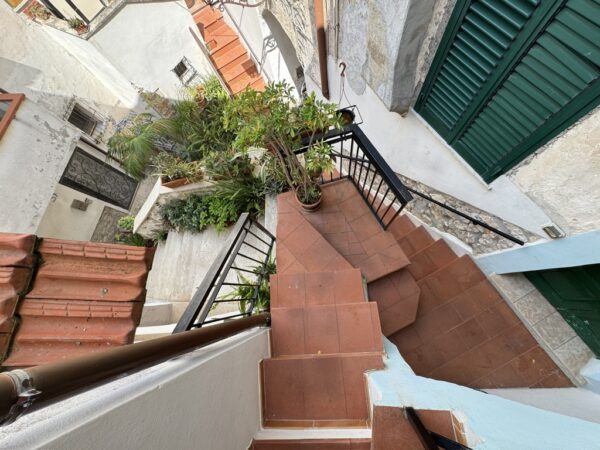
今後の展望
今回、作品制作に当たってMaranola に3週間ほど滞在した。その中で気づいたことがたくさんある。まず、坂と階段だらけの街Maranola では、高齢者が圧倒的に元気である。毎日、階段を登り降りして生活しているために、足腰が鍛えられるのだろう。しかし、それだけではない。Maranola のほとんどの階段は地形に合わせて自然発生的に生まれたり、増築に増築を重ねた結果としてできてしまったりした階段である。すなわち、ほぼ全ての階段の幅も勾配も違い、踏面や蹴上寸法も違う。また、微妙に角度が歪んでいたり、石やタイルの材料が違っていたりする。そのため、街の人たちは、視覚情報をもとにそれらを認識しながらも、一歩一歩足の感覚を確かめながら、体のバランスを取りながら、注意深く階段の昇降が強いられる。この街自体がある意味まるで「手続き型建築」のように思えてきた。今後、この街の調査することで、今後の「手続き型建築」の計画にインスピレーションを得ることができるのではないかと思った。
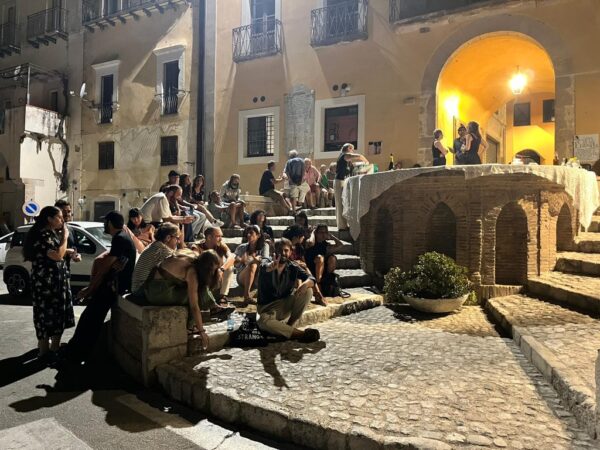
もともとの予定では、「蜃気楼階段」の設計図面を日本からイタリアに送り、それをもとに現地で作品を制作してもらい、私は、作品が完成してからイタリアに渡航し、レクチャーを行うためだけに数日滞在する予定だった。しかし、今回、不足の事態で長期に現地に滞在することになった。そのおかげで新しいコンセプトを考えられ、新しい作品も制作することができ、おまけにマラノラの魅力にも出会うことができた。まさに塞翁が馬のような経験だった。現地で行ったレクチャーには、アーティスト、キュレーター、研究者だけでなく、多くの地元の方も参加してくだり、大変みのりの多い時間であった。
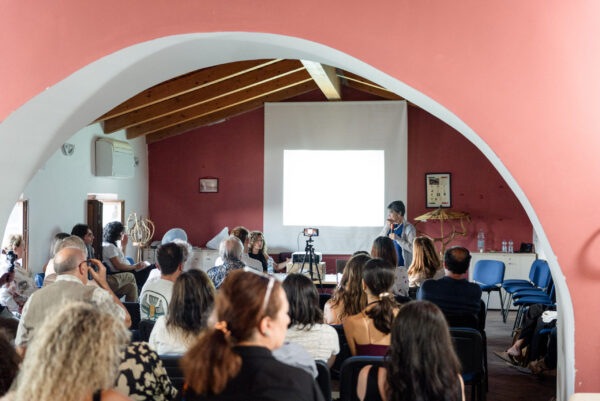
“Mirage Stairs/Maranola” – Scale-Juggling Escalator –
Report on the “Mirage Stairs” Project in Maranola, Italy
2025.9.29 Yumi Kori
“Mirage Stairs/Maranola” is a mockup of a new “procedural architecture” created in the medieval town of Maranola, Italy. “Procedural architecture” is a concept of architecture advocated by artists Shusaku Arakawa and Mudslinging. Architecture is typically used in everyday life through numerous “procedures” in relation to the human body. “Procedural architecture” is architecture intentionally designed to reexamine known “procedures” and create new relationships and environments between architecture and humans. “Procedural architecture” has a “method of use,” and the idea is that by using it in accordance with that method, humans are reshaped and their divine will is reversed.
I will explain the background and circumstances behind the creation of this new “Mirage Stairs/Maranola” in Italy later, but first, I would like to explain the work itself.
About the Installation Location: The site is located in Maranola, a medieval walled city on the west coast of Italy, on a plateau between Rome and Naples. Because the city is built along the undulating terrain of the mountains that rise steeply from the coast, there are almost no flat roads; instead, it is a complex network of sloping alleys and staircases. These staircases also extend into the homes, with several houses stacked on top of each other intricately, extending upward. At the top of the stairs, one is invited to a rooftop terrace offering a panoramic view of the surrounding mountain and seascape. In this town, the earth, the city, homes, and life are organically connected by stairs.
Residents of this town are surrounded by stairs every day, both on the street and in their homes. From birth to death, they ascend and descend them countless times as needed. For those born and raised in this town, stairs are part of the earth, part of the city, and part of the architecture; they are an essential part of daily life. The Mirage Stairs were installed in a small courtyard in the middle of this staircase-filled town.
Transforming the courtyard into “procedural architecture.”
The small courtyard, with its eight staircases and seven houses intricately intertwined vertically and horizontally, resembles a three-dimensional Escher painting. In this project, I attempted to transform the courtyard into “procedural architecture” through the staircases that are most familiar to the people of Maranola. First, I investigated the orientation of the seven existing staircases and installed two “frame staircases” with different vectors suspended in the middle of the square. The lower one is approximately half the size of a regular staircase, while the upper one is approximately two-thirds the scale. To make them appear unconstrained by gravity, the upper “frame staircase” is turned upside down and suspended in the air at a slight angle. I then painted them with fluorescent paint so that they glow after sunset. The existing stairs, visible during the day, are shrouded in darkness at night, leaving only the floating frame staircase visible.
How to Use “Mirage Stairs/Maranola”
Climbing and descending the intricately intertwined courtyard stairs, visitors can stop wherever they like to view the two floating “Frame Stairs” and seven existing staircases from various heights and directions. Enjoy the sensation of the courtyard’s shape changing and the sense of being upside down depending on your perspective. Depending on your location, the “stairs” may appear different in size or upside down, and your own body may appear larger or smaller, disrupting your sense of balance. By shifting your perspective, you can imagine the “stairs” not as something to climb, but as a gateway to another world that may lie beyond.
After sunset, the existing stairs disappear, allowing viewers to recognize their existence through their physical senses as they ascend and descend. At the same time, imagine climbing the inaccessible “Frame Stairs” and enjoy the discrepancy between physical and visual spatial awareness.
Access your “procedural memory” with a sense of bewilderment.
The two “frames” floating in the air are the familiar shape of stairs, so people who see them immediately recognize them as “stairs.” However, in reality, they are made of thin frames and cannot be climbed. Furthermore, they are scaled down compared to regular stairs, and are significantly smaller than the size an adult can functionally ascend and descend. Furthermore, they are floating in the air, with the upper steps hanging upside down at an angle. After people see them and recognize them as “stairs,” a process occurs in their brains to determine whether they are actually large enough to ascend using their own bodies. This likely causes people to go back and forth between their physical sensations and spatial perception. Furthermore, as people ascend and descend the actual stairs in the courtyard, they perceive the frame stairs from various angles, and will likely feel confused between stairs they can climb and stairs they cannot. Through the sensations they acquire here, new relationships will be formed between “stairs” and people, and ultimately between architecture and people, and between the town and people, and the courtyard itself will be transformed into “procedural architecture.” Considerations on Scale-Juggling
How the human brain interprets scale and links it to behavior has been studied in the fields of psychology and cognitive science. First, visual information is transmitted flatly to the retina, so initially, the difference between the size of an actual object and a scale model is indistinguishable. However, it is said that the brain takes into account information such as light, shadow, and depth, and refers to empirical data to understand scale. It then translates this into bodily sensations, which are then used to simulate, judge, and act internally. In other words, when ascending or descending a real staircase and encountering a “staircase” that is subtly different in size and cannot actually be climbed, the experiencer’s brain, perception, procedural memory, and bodily sensations interact in a different way, potentially updating their “architectural body.”
Concept of the Mockup
By experiencing an existing staircase while viewing a subtly scaled-down version from various angles, we hope to enable viewers to gain a sense of their own relative size and that of their surroundings. We also hope to develop a keen awareness of their own body in relation to space, including their feet, hands, weight distribution, sense of balance, and eye movements. The idea was for the color, shape, inclination, and form of this staircase to create a sense of discomfort and dissonance, shaking up people’s physical senses and spatial perception, and bringing freshness to everyday spaces. Furthermore, stairs are not simply functional; they have the power to appeal to the viewer’s emotions and inspire their imagination. It is my hope that this piece will further expand people’s physical awareness through their imagination.
“Biotopological Scale-juggling Escalator”
“Mirage Stairs/Maranola” was inspired by “Biotopological Scale-juggling Escalator,” a late work by Shusaku Arakawa and Madeline Gins. This piece, realized in collaboration with Comme des Garçons, is an actual staircase connecting the third and fourth floors of Dover Street Market in New York City. It is called the “Reversible Destiny Lifespan Extending Module.” While functional and part of an actual building, each staircase features a different material and color, diversifying the rhythm of walking and the physical sensations experienced while ascending and descending, stimulating the viewer’s spatial awareness. Scaled models of several modular “rooms” (wings) are embedded in the staircase’s walls, allowing the viewer to sense their own relative size and the size of their surroundings, potentially challenging their familiar physical perceptions. The goal is for the body to develop a new relationship with the surrounding space (architectural environment) through “climbing and descending the stairs,” stimulating both cognition and sensation.
Background to the Creation of “Mirage Stairs/Maranola”
“Please install Mirage Stairs in Italy!” This spring, I received such a delightful request. They asked me to exhibit it and give a lecture at the Public Art Biennale, to be held in Maranola, Italy, from August 28-30, 2025. It started when I was talking to an Italian curator Isabella who was visiting Japan recently about my research into “procedural architecture,” showing her photos of the “Mirage Stairs” prototyped in Osaka last year. We agreed to send the blueprints for the “Mirage Stairs” to Italy and have them proceed with the construction in Italy.
However, in early August, I received an urgent call from the curator. They told me that they couldn’t get the materials they had planned, so they couldn’t build the “Mirage Stairs” as planned. The program for the Biennale had already been announced. They absolutely had to build the “Mirage Stairs.” So, they asked me to build a “Mirage Stairs” using materials available locally, with the technical skills of local craftsmen. However, in order to quickly come up with a feasible alternative that followed the concept of the “Mirage Stairs,” I absolutely needed to go to Italy. So, I quickly flew to Italy earlier than planned. When I visited the courtyard in Maranola where I planned to install the work, I found it to be much smaller than it appeared in photographs. However, upon counting, I discovered a total of seven staircases and eight houses intertwined in three dimensions, creating what appeared to be an immeasurable expanse of space. This led me to the idea of creating a new procedural architectural mockup, “Mirage Stairs/Maranola,” focusing on “size” and “scale.” Furthermore, because I felt a spatiality reminiscent of an Escher painting, where the sky and the earth are turned upside down, I wanted to create a work that also taps into the “sense of heaven and earth.” I also became interested in the perception of how the same object appears differently depending on whether it is practical or non-practical.
Future Outlook
I spent about three weeks in Maranola creating this work. During that time, I noticed many things. First of all, in Maranola, a city full of slopes and stairs, the elderly are overwhelmingly energetic. Perhaps climbing and descending stairs every day strengthens their legs and backs. But that’s not all. Most of Maranola’s stairs were either created naturally to fit the terrain, or as a result of repeated extensions. This means that almost every staircase is different in width, slope, tread, and riser dimensions. They are also slightly distorted in angle, and the stone and tile materials used are different. As a result, the residents of the city are forced to carefully ascend and descend the stairs, relying on visual information to recognize these details, while checking the sensation of their feet with each step and balancing their bodies. In a sense, the city itself seems like a “procedural architecture.” I believe that by investigating this city in the future, I may be able to find inspiration for future “procedural architecture” ideas.
